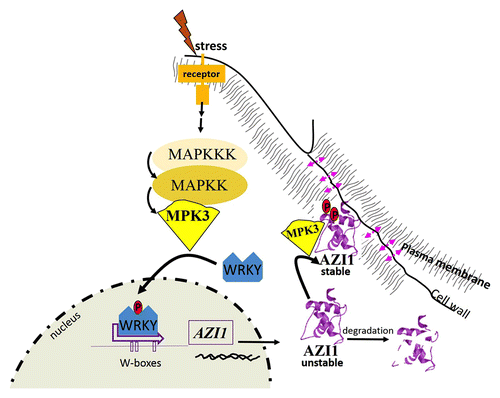Figures & data
Figure 1.AZI1 1000 bp upstream regulatory region. Putative cis-regulatory elements potentially targeted by MPK3-activated transcription factors are highlighted. (reverse orientation underlined). MBSII (blue), VRE (gray), W-box (red).

Figure 2. Proposed model of AZI1 regulation in MPK3-mediated stress responses. Stress perception initiates MAPK cascade signaling. Stress-activated MPK3 phosphorylates WRKY transcription factor(s) (blue), which subsequently induce AZI1 gene expression through binding to W-boxes in the AZI1 Promoter. In mpk3 mutants, AZI1 protein is unstable. AZI1 and MPK3 interact at the plasma membrane; and a cell-cell-contact appears to be required for complex formation (pink arrows). Phosphorylation by MPK3 likely stabilizes the AZI1 protein.

Figure 3. Optimised AZI1 variant proposed for genetic engineering. Top: schematic image of AZI1 primary protein sequence. The region spanning the 5 putative MAPK phosphorylation sites is highlighted and enlarged. Replacing all or a subset of these residues by phosphomimetic amino acids is expected to improve AZI1 protein stability and to make AZI1 protein function independent of MAPK phosphorylation.

